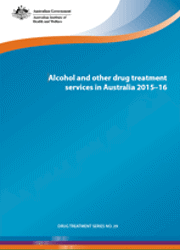Alcohol and other drug treatment services in Australia 2015–16
Citation
AIHW
Australian Institute of Health and Welfare (2017) Alcohol and other drug treatment services in Australia 2015–16, AIHW, Australian Government, accessed 20 April 2024.
APA
Australian Institute of Health and Welfare. (2017). Alcohol and other drug treatment services in Australia 2015–16. Canberra: AIHW.
MLA
Australian Institute of Health and Welfare. Alcohol and other drug treatment services in Australia 2015–16. AIHW, 2017.
Vancouver
Australian Institute of Health and Welfare. Alcohol and other drug treatment services in Australia 2015–16. Canberra: AIHW; 2017.
Harvard
Australian Institute of Health and Welfare 2017, Alcohol and other drug treatment services in Australia 2015–16, AIHW, Canberra.
PDF | 3.7Mb
In 2015–16, about 796 alcohol and other drug treatment services provided just over 206,600 treatment episodes to an estimated 134,000 clients. The top 4 drugs that led clients to seek treatment were alcohol (32% of treatment episodes), cannabis (23%), amphetamines (23%), and heroin (6%). The proportion of episodes where clients were receiving treatment for amphetamines has continued to rise over the 5 years to 2015–16, from 12% of treatment episodes in 2011–12 to 23% in 2015–16. The median age of clients in AOD treatment services is rising, from 31 in 2006–07 to 33 in 2015–16.
- ISSN: 2205-5088 (PDF) 1447-6746 (Print)
- ISBN: 978-1-76054-142-2
- Cat. no: HSE 187
- Pages: 85
-
An estimated 133,895 clients received just over 206,000 treatment episodes from alcohol & other drug treatment agencies
-
A total of 796 publicly-funded alcohol and other drug treatment agencies provided services to clients
-
Around 1 in 7 AOD clients (14%) were Aboriginal and Torres Strait Islander people
-
The principal drugs that led clients to seek treatment were alcohol, amphetamines, cannabis and heroin



